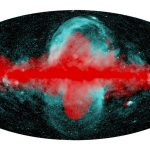Astronomers find blinking giant star near heart of Milky Way0
- From Around the Web, Space
- June 11, 2021
Huge star, 25,000 light years away, dims by 97% then slowly returns to former brightness

Huge star, 25,000 light years away, dims by 97% then slowly returns to former brightness

We sort-of take it for granted that there’s a supermassive black hole at the center of the Milky Way galaxy, but we can’t really go there and check. What if something else is actually lurking in this messy, dusty region?

Most of the galaxy’s disk was in place before a major collision 10 billion years ago

Astronomers using data from NASA’s Fermi Gamma-ray Space Telescope have identified 14 candidate antistars — stars made of antimatter — in our Milky Way Galaxy.

A mysterious wake of stars, stirred up by a small galaxy that is set to collide with the Milky Way, could be about to unlock the mysteries of dark matter.

The highlight of the new chart is a wake of stars, stirred up by a small galaxy set to collide with the Milky Way. The map could also offer a new test of dark matter theories.

Most of the alien civilizations that ever dotted our galaxy have probably killed themselves off already.

A powerful blast from the supermassive black hole may explain a lack of large, red stars there

Scientists have known for a decade that two bubbles of charged particles, or plasma, flank the plane of the Milky Way. Those structures, known as the Fermi bubbles after the telescope that detected them, are visible in high-energy light called gamma rays. But now, the eROSITA X-ray telescope has revealed larger bubbles, seen in X-rays. The X-ray bubbles extend about 45,000 light-years above and below the center of the galaxy, researchers report online December 9 in Nature.

Source: Phys.org Scientists working with data from the Sloan Digital Sky Surveys’ Apache Point Observatory Galactic Evolution Experiment (APOGEE) have discovered a “fossil galaxy” hidden in the depths of our own Milky Way. This result, published today in Monthly Notices of the Royal Astronomical Society, may shake up our understanding of how the Milky Way